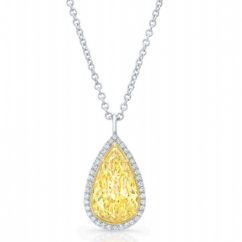Articles and News
McKinsey & Co. Outlines Six Seismic Shifts Coming In The Luxury Jewelry And Watch Industry June 29, 2021 (0 comments)

Zurich, Switzerland—A new report from global consultancy McKinsey &Co., in collaboration with New Jersey-based The Business of Fashion, has identified six seismic shifts that will impact luxury jewelry and watch retailing in the next five years. Image: a 3.89-ct fancy yellow pear shape diamond with 0.22 ctw round white melee, $82,990, from Rahaminov.
Between now and 2025, McKinsey expects the global jewelry and watch industries to grow 3-4% per year (fine jewelry) and 1-3% per year (premium to ultra-luxury watches), from approximately $49 billion in retail value in 2019 to a projected $52-$59 billion by 2025.
McKinsey has identified six major shifts—three each in jewelry and watches—that will greatly impact the retail market in the next few years. For luxury fine jewelry retail, they are:
1. Online. Online fine jewelry sales are projected to account for between 18% and 21% of total sales by 2025, up from 13% in 2019, says the report. The challenge of replicating the in-person experience online slowed the category’s digital growth but that’s starting to change. McKinsey says the onus is on brands and retailers to create compelling propositions that connect the human with the digital screen. Meanwhile, auction houses like Christie’s are competing for customers they’ve never had before and encroaching on independent jewelers' turf.
2. Brands. Despite the prominence of iconic brands, McKinsey says branded jewelry currently only accounts for 20% of total fine jewelry market revenue. But brands are on the rise and their share of market should reach 25-30% percent by 2025, or about $80-$100 billion in sales. Michael Burke, chairman and chief executive of Louis Vuitton, told McKinsey that fine jewelry is one of—if not the—highest-growth categories the conglomerate has.
3. Sustainability. By 2025, an estimated 20-30% percent of global jewelry sales will be influenced by sustainability-minded consumers and it’s going to be important to win the trust of younger consumers, says McKinsey.
For luxury watch retail, the shifts are:
1. Direct-to-consumer (DTC). Brick and mortar retail has been the lifeblood of luxury watches, with multi-brand retailers (i.e. jewelers) owning the customer relationship. But as consumers demand to interact more directly with brands and expect better online shopping opportunities—and brands aim for higher margins—watchmakers will grow their DTC channels from about one fifth (20%) of the market to almost one-third (30%) by 2025, with $2.4 billion in annual revenues shifting from retailers to brands, says the report.
2. Secondhand. Sales of pre-owned watches are expected to become the industry’s fastest-growing segment, rocketing from $18 billion in 2019 to $29-32 billion annually in 2025.
Related: Pre-Owned Jewelry Leads Secondhand Luxury Goods Market
3. Midmarket squeeze. The traditional watch midmarket is under rising pressure from fashion brands, smart watches, and customers “trading up” into the luxury segment. Absent revitalization, McKinsey expects traditional midmarket watch brands could decline by $2.5 billion in revenues by 2025.







